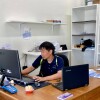Mask Up: How Do You Say Hello When Nobody Can See You Smile?
The following article was originally published April 13, 2020, and republished through a collaboration with KPCC and LAist.
Story by Sharon McNary
It's our new reality: Angelenos are now required to wear a mask when visiting grocery stores and other essential business. Some jurisdictions, like San Bernardino County, are even stricter, asking you to wear a mask when you leave home.
These rules are meant to reduce the spread of the coronavirus, but it's challenging our social conventions.
Under a mask, nobody can see you smile.
You may think we can see you smile with your eyes, or smize, as supermodel Tyra Banks puts it. But when your glasses are fogged up with vapor exhalation, all those droplets that you're politely keeping to yourself, you're not really expressing your friendliest self.
What L.A. needs now is a robust new vocabulary of hand gestures that say, "Hello, neighbor. I care."
We're all relying on new body language — the finger guns, Namaste prayer hands.
Or heart hands, V for Victory, a Japanese-style bow, the closed hand to the chest, Hawaiian shaka greeting, rock-and-roll horns, thumbs up or a solidarity fist.

KPCC/LAist visual journalist Chava Sanchez captured some of the new ways we are saying hello.
Kristina Wong has been meeting new people all over L.A. as she delivers supplies for a volunteer mask-sewing group. And she finds it a challenge to come up with the right hand gestures to replace a smile.






"I just find myself going, 'Hello. Thank you for working,' like, through my mask. And having this like love and heroic appreciation for them."
But wearing masks isn't just new and uncomfortable — for some people of color it can make them feel like a target.

"I'm not going to put on something that causes me to stand out in a negative way," said Sheldon Wright, an African American resident of Monrovia who works for an insurance company.
He sewed part of a white-and-brown plaid handkerchief on the outside of his mask. The hankie belonged to his late father, who died of pneumonia four years ago, so it has sentimental value.

And it prompts interested conversation from people like checkout clerks, whose parents might also have owned similar handkerchiefs.
While wearing a mask, "you can't see my smile, you can't see what I believe about me (and what) makes me approachable. I need to find other ways to convey I am still approachable," Wright said.



Me? I give people I know a full hand wave and maybe a chin pop.
Or, as in this photo, where I'm attempting a smize.




